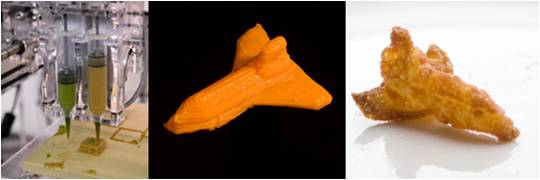3D printing is a catch-all term for several different additive manufacturing processes (there will be an upcoming space_girlie blog to look at these in a bit more detail), and is being positioned as one of the next disruptors for the space industry.
There is a growing community of commercial firms out there who are pioneering the technologies, processes and applications and actively stimulating the growth of a brand-new market for 3D printing for space. The difficulty of these activities cannot be underestimated, however, the fact that these companies are already proving the feasibility of these concepts means that the conditions for commercialization are also being established.
1. Planetary Resources of Bellevue, Washington, is leading the pack of commercial space rock miners and has financial backing from Google's Larry Page and other high-profile technology leaders.
They have already built full-scale mechanical prototypes of their Arkyd-100 space telescope for asteroid prospecting applications from low earth orbit. I’m looking forward to DSI’s announcement of the launch date for their first technology demonstration mission.
2. Deep Space Industries (DSI), based in McLean, Virginia is planning to survey asteroids, mine them for resources and convert the raw materials into products, while in space, using 3D printers. DSI recently announced their plans to deploy a fleet of small satellites on deep-space missions to prospect for resource-rich asteroids. Using low-cost Cubesat technology, their first cluster of 25kg FireFly satellites are scheduled for a 2015 launch, followed by a sample return mission using their DragonFly spacecraft in 2016. They’ll then use their MicroGravity Foundry 3D printer to convert the asteroid materials info metal parts.
3. Tethers Unlimited, in Bothell, Washington, is teaming with NASA on the SpiderFab concept to develop the technologies to print large structures in space, eliminating the need to use large launch vehicles to carry them to orbit,. Their longer-term goal is to be able to fabricate all of the parts for a satellite in space usind additive manufacturing techniques. They’ve already demonstrated 3D printing of radiation shielding and have been awarded a $100k study to develop space-based 3D printing processes capable of manufacturing apertures measuring around a kilometer across.
4. Made In Space has already proved the 3D printing process by fabricating tools during over 400 parabolas of microgravity flights since Summer 2011. They plan to send the first 3D printer into space to operate on the International Space Station in 2014, following more microgravity tests this summer.
5 & 6. A consortium including 2 British firms, Foster+Partners and Monolite, is working with the European Space Agency to explore the feasibility of using 3D printing to build an astronaut base on the moon, using the Lunar soil itself as the raw material.
 |
| Planetary Resources' Arkyd-100 LEO space telescope |
 |
| Deep Space Industries' FireFly series concept |
 |
| Tethers Unlimited's on-orbit manufacture of large space apertures |
 |
| Made In Space is flying the first 3D printer in space in 2014 |
 |
| ESA, Foster+Partners and Monolite are developing a concept to use 3D printing to build a lunar base |
7. Concept Laser, a leading industrial laser machine company based in Germany has supplied NASA with a 3D printing system that will be manufacturing rocket engine parts for NASA’s Space Launch System, the next heavy-lift launch vehicle for delivering cargo, crew and instruments into low Earth orbit as well as deep space missions.
8 & 9. DIYROCKETS and Sunglass.io are also looking at launch vehicle applications – at the other end of the kilograms-to-orbit lift scale. They recently announced a competition to find a collaborative team to design a 3D printed rocket engine for delivering nanosatellites into orbit, with the aim of stimulating low-cost innovations to increase opportunities for space exploration.
 |
| DIYROCKETS and Sunglasses.io want to use 3D printing to build launchers for cubesats [Ninkonaft/Shutterstock] |
10. And finally, a team looking at how to nourish our astronauts and stop them getting bored with the same ol’ pre-packaged food on long missions: the fab@home 3D printer created out of Cornell University is using edible gels and flavors to create a range of different foods with realistic tastes and textures.
Are there any other companies to add to this list?
S_G


No comments:
Post a Comment